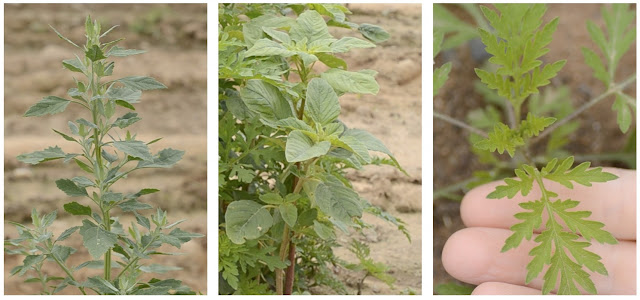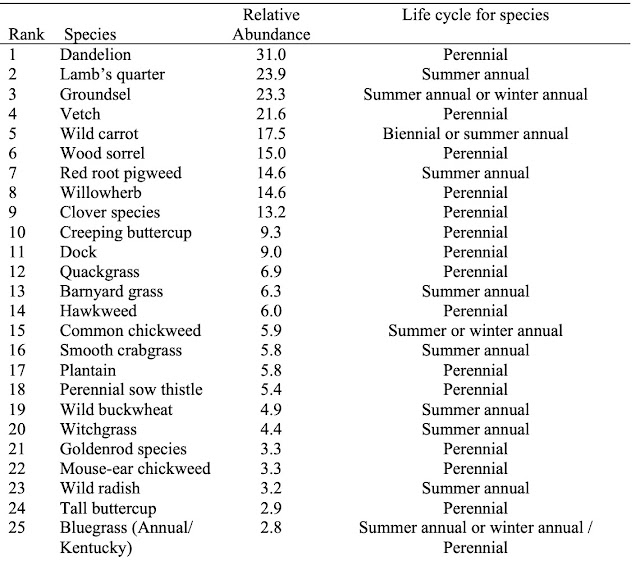Winter Annuals in Our Orchards
The life cycle of winter annual weed species is that they germinate in the fall, overwinter, and then produce seeds in spring or early summer. Winter annuals typical in Nova Scotia orchards include common groundsel, common chickweed, bluegrass, daisy fleabane, Pennsylvania bittercress, scentless chamomile, shepherd’s purse, henbit, and deadnettle (Figure 1). In the early days of spring, these winter annuals are the first you’ll see because they restart growth when the weather warms up. By the time weed management fits into your schedule, these weeds can be too large and are therefore past their treatable stage.Figure 1: Winter annuals typical in Nova Scotia orchards from left to right: common groundsel, common chickweed, and bluegrass.
For comparison, note that the summer annuals typical in Nova Scotia orchards are lamb’s-quarters, common groundsel, wild carrot, red root pigweed, barnyardgrass, common chickweed, smooth crabgrass, wild buckwheat, witchgrass, wild radish, bluegrass, prostrate knotweed, foxtail, common ragweed, daisy fleabane, and spotted lady’s thumb (Figure 2). The summer annuals are at treatable stages for relatively longer than winter annuals in spring.
Figure 2: Summer annuals typical in Nova Scotia orchards from left to right: lamb's-quarters, red root pigweed, and common ragweed.
Management Strategies in Relation to Weed Biology
I recently listened to a podcast episode of ‘Out Standing in the Field’ that was co-hosted by my colleagues Caitlin Congdon and Sonny Murray with guest Mike Cowbrough. The focus was on weed management in winter wheat but aspects of the conversation are relevant to our tree fruit crops. Similar to winter wheat, our perennial crops can run into issues with pressure from winter annuals.In the podcast, Mike emphasized how knowing aspects of weed biology can help with management decisions. Some weeds are summer and winter annuals so depending on when the seeds germinate, management might need to target both populations that germinate in fall and spring (Figure 3). Taking scentless chamomile as an example, they found that neither fall nor spring treatment alone was sufficient for control in cereals. He also mentioned the importance of fall management for the winter annual purple deadnettle, as opposed to spring management.
Figure 3: Photos of common groundsel taken on September 17, 2021 at the flowering stage (left) of a summer annual and a newly germinated winter annual (right).
For bluegrasses, knowing the type of species whether annual, Kentucky, or roughstalk is helpful for herbicide selection. But identification is tricky, so molecular analysis is preferred for a cost of about $20. Contact me for more information if you have concerns about bluegrass or need help identifying grassy species.
Bluegrass species that are winter annuals germinate in the fall and can grow quickly in the spring. The trouble is that post-emerge products work best at the 2-4 leaf stage, which could happen as early as May and would make spring bluegrass management a challenge in busy orchards. Also, bluegrass species have been difficult to treat post-emerge in young orchards in particular because options are limited. The seemingly recent occurrence of bluegrass issues could be a result of losing the post-emerge product gramoxone. Also, glyphosate is not very effective on bluegrass.
The pre-emerge options could prove to be a helpful approach. For example, Dual II Magnum provides pre-emerge management of grasses and likely has activity on Kentucky bluegrass although the species is not listed on the Canadian label. First Ignite could be used to burn down the existing weeds and then Dual II Magnum could be applied before new orchard grass germinates. Dual II Magnum applied with Princep would offer a broader range of control for broadleaves resulting in pre-emerge and long-term control.
Bluegrass species that are winter annuals germinate in the fall and can grow quickly in the spring. The trouble is that post-emerge products work best at the 2-4 leaf stage, which could happen as early as May and would make spring bluegrass management a challenge in busy orchards. Also, bluegrass species have been difficult to treat post-emerge in young orchards in particular because options are limited. The seemingly recent occurrence of bluegrass issues could be a result of losing the post-emerge product gramoxone. Also, glyphosate is not very effective on bluegrass.
The pre-emerge options could prove to be a helpful approach. For example, Dual II Magnum provides pre-emerge management of grasses and likely has activity on Kentucky bluegrass although the species is not listed on the Canadian label. First Ignite could be used to burn down the existing weeds and then Dual II Magnum could be applied before new orchard grass germinates. Dual II Magnum applied with Princep would offer a broader range of control for broadleaves resulting in pre-emerge and long-term control.
Weed Control Programs
Most winter and summer annual weed seeds germinate in the top ½ inch of soil, so pre-emergence treatments are most effective when rained in to the ½ depth of soil. The idea with residual herbicides is that if the viable weed seeds are killed by the treatment, then the undisturbed soil surface will be weed free even after the chemical has degraded over time.Consider the benefits of treating annuals pre-emerge, especially in young orchards to rely less on post-emerge products. Post-emerge products applied late to tall weeds run the risk of damaging the tender young bark of trees. Good weed control is critical in young orchards to maintain access to resources for tree vigour to fill the space.
A fall weed control trial by Cornell Cooperative Extension in 2014 through 2016 showed that, “Untreated weedy checks and plots without residual herbicide in the fall were the first to break through the suggested PWC [percent green weed cover] threshold of 20% by 19 May in the midst of petal fall insecticide, fungicide, and late fire blight sprays.” Refer to the article directly for more information about herbicides and rates used in their 2-year program. Please note that not all products and uses are allowed in Canada and that Canadian pesticide labels should be consulted. Visit the Tree Fruit Weed Management Guide for a summary of available options.
Fall weed control does have its limitations. A major limitation is that the residual herbicide should be distributed evenly on a soil surface to uniformly prevent seed germination. But in the fall the herbicide strip can be covered with dropped apples, root suckers, tall weeds, and leaves. A residual herbicide is best applied to bare ground.
Pesky Perennials
Next, let’s turn our attention to perennial weeds. Soon they’ll be shutting down but in the meantime before a hard frost they’re storing reserves in their roots for next year. Perennials commonly found in Nova Scotia orchards are dandelion, vetch, sorrels, willowherb, buttercups, dock, quackgrass, hawkweed, plantains, perennial sow thistle, goldenrod, mouse-eared chickweed, thistle, horsetail, catchweed bedstraw, yellow toadflax, St. John’s wort, ground ivy, and scentless chamomile (Figure 4). The 2020 survey by the NSDA suggests that established orchards are challenged with control of perennial weed species because perennials rank high in terms of abundance (Table 1).Figure 4: Perennials typical in Nova Scotia orchards from left to right: vetch, dock, and St. John's wort.
Table 1: A weed survey done by the Nova Scotia Department of Agriculture in 2020 at 37 orchard blocks in Nova Scotia. Species are ranked by relative abundance determined by the survey. Table modified to show the life cycle for the top 25 listed species.
To kill the life-giving roots of perennial weeds, an herbicide applied to the foliage needs to be transported to the roots. In the early spring during rapid leaf growth, the resources are directed away from the roots so an herbicide like 2,4-D that behaves like a food metabolite is not translocated to the roots. Whereas in the late spring and early fall, resources are being stored in the roots and 2,4-D could tag along. Perennial weeds on the label for 2,4-D could be treated post-harvest (because of the 80-day PHI). Just keep in mind that perennial weeds should be treated while they are green and growing, prior to a hard frost.
Also, take note of perennials before tillage practices especially if they have rhizomes or spread vegetatively. Prepare the site with glyphosate and 2,4-D prior to tillage to limit the spread of creeping perennials like sorrels, sow thistle, mouse-eared chickweed, ground ivy, quackgrass and Canada thistle.
However, if you’re planning to use glyphosate for perennial weed control in established orchard, wait until a late spring application timing. Fruit trees are currently storing reserves in the roots for next year’s growth so glyphosate can be damaging if taken up and transported to the tree’s root system.
Takeaways
- Winter annuals like common groundsel, common chickweed, and bluegrass can grow past their treatable stage quickly in spring.
- Summer and winter annual species have populations that germinate in both fall and spring and therefore troublesome weeds may need to be managed at both times.
- Bluegrass species should be identified by molecular analysis to inform herbicide choice.
- Products to manage bluegrass species in young orchards are limited so pre-emerge options should be considered and may need to be applied prior to fall grass germination.
- After harvest, consider using a post-emerge herbicide to clean up weeds along with a residual product to save time early next season. Orchards without fall application of residual herbicides are expected to exceed weed thresholds in early spring before those treated with residuals.
- Fall pre-emerge herbicides should be applied to bare ground for uniform control.
- The majority of weed species by abundance in established orchards are perennials including dandelion, vetch, and wood sorrel. Site preparation is an important first step to limit creeping perennials.
- After harvest there is an opportunity to treat perennials when they are storing reserves in their root systems before a hard freeze.
- If planning to apply glyphosate, wait until late spring to avoid translocation to fruit tree root systems.
Even if you are not set up to perform weed control in the fall, now is a good opportunity to identify what weed species are present to inform herbicide choices for early next year.
References:
- Congdon, Caitlin. “Out Standing in the Field: Weed Management in Winter Wheat with Mike Cowbrough.” Perennia, September 8, 2021, https://anchor.fm/out-standing-in-the-field/episodes/Out-Standing-in-the-Field-A-Podcast-by-Perennia-e15pd6j.
- Klingman, Glenn C. 1961. Weed Control: As a Science. John Wiley & Sons, Inc. pp. 1-421.
- Breth, D., Tee, E., Donahue, D., and Wallis, A. 2016. Managing Apple Orchard Weeds in the Fall. New York Fruit Quarterly. 24 (4), 9-16. https://nyshs.org/wp-content/uploads/2017/03/Breth-Pages-9-16-from-NYFQ-Book-Winter-2016-4.pdf
- Nova Scotia Department of Agriculture (NSDA) survey of 37 orchard blocks in 2020
- Bouchard, C.J., and Neron, R. 2003. Identification guide to the weeds of Quebec. Conseil des productions vegetales du Quebec Inc. pp. 1-251.
- Palfrey, G.D. 1986. Weeds of Nova Scotia. Department of Agriculture and Marketing. Province of Nova Scotia. ISBN 0-88871-063-1. pp.1-95.
- LeBlanc, L. and McCully, K. Weed Identification Guide. Agriculture Canada, Nova Scotia Department of Agriculture and Marketing, New Brunswick Agriculture. pp.1-51.
- Cowbrough, M., Tardif, F., and Letarte, J. 2016. Weed ID Guide for Ontario Crops. Grain Farmers of Ontario. pp 1-270. http://fieldcropnews.com/2016/09/weed-id-guide-for-ontario-crops/
- Private communications with Sonny Murray, and Kristen Obeid for bluegrass management. This post is not a reflection of their views.





